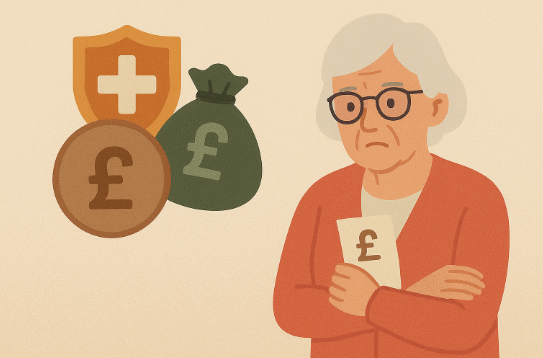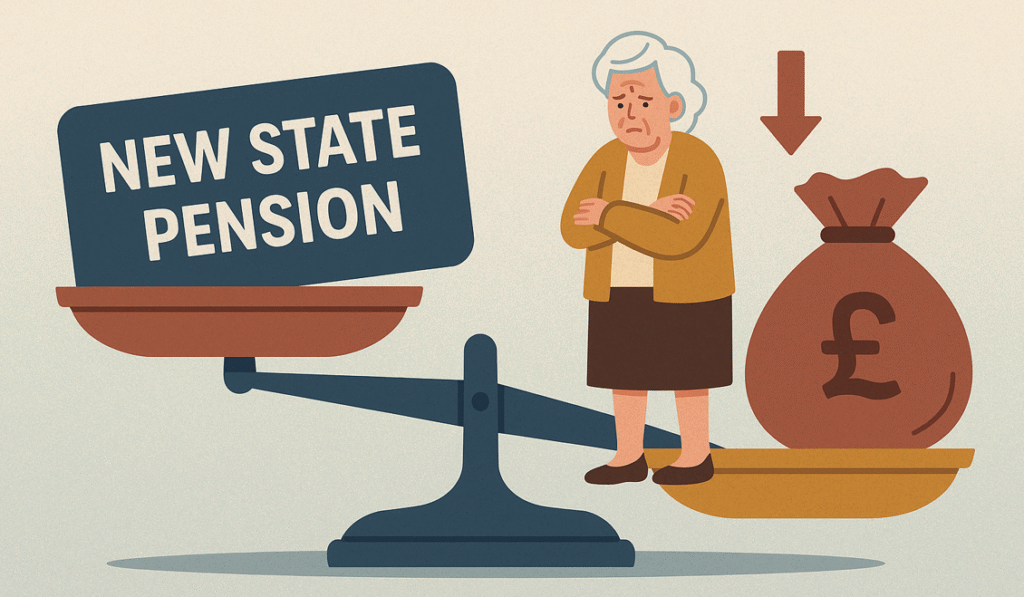The question “Is the New State Pension unfair to existing pensioners?” echoes a growing concern in the UK. Pensioners who retired before 6 April 2016 often feel financially and systematically sidelined. Despite similar work histories and National Insurance contributions, they receive significantly less than those under the new flat-rate system. This discrepancy has ignited debates about fairness, transparency, and equity in retirement policy.
What is the New State Pension and How Does it Compare with the Old Pension System?
How do the old and new systems differ in structure and payment?
- Old System (Pre-2016):
- Basic State Pension: approx. £156.20/week
- Additional Pension via SERPS or S2P (variable)
- Contracting out reduced eligibility
- New System (Post-2016):
- Flat-rate pension: up to £221.20/week in 2024
- No additional pension
- Based solely on National Insurance record
| Feature | Old System | New System |
|---|---|---|
| Max Weekly Pension | £156.20 + SERPS | £221.20 |
| Contracting Out Penalty | Yes | No |
| Complexity | High | Low |
| Transparency | Poor | Improved |
Why is the new system considered more generous?
- Simplified entitlement rules
- Full payout at 35 qualifying years
- No deductions for contracting out
Who Loses Out the Most Under the New State Pension System?
Are men more affected than women?
According to pensions expert Steve Webb, the average man loses slightly under the new system, while women often gain. Historically, men had higher earnings and were more likely to be contracted out, which lowers their old State Pension.
How are expatriates impacted by frozen pensions?
- Over 500,000 UK pensioners abroad receive “frozen” pensions.
- Their payments don’t increase with inflation.
- Pensioners in Canada, Australia, and parts of Africa lose up to £26,000 over 15 years.
How did public and private sector workers fare?
- Many public workers (nurses, teachers) were automatically contracted out.
- Private sector workers in DB schemes were also affected.
- Deductions due to contracting out result in up to £65 less per week.
How Has Contracting Out Affected Pension Fairness?
What was contracting out and why was it popular?
Enabled reduced NI contributions in exchange for private/occupational pensions.
-
- Misunderstood consequences: led to deductions from State Pension.
- Often arranged by employers without employee understanding.
- Widely promoted by the government without full disclosure of future impact.
- Records related to contracting out are often unclear or missing.
- The reduction is permanent, with no adjustment mechanism.
- Many affected individuals had no choice in opting out.
Why does the penalty no longer apply?
- The 2016 reform abolished contracting out.
- New pensioners are unaffected, deepening the perceived injustice.
- Older workers who paid into the system under different rules now see lower returns.
- There is no retroactive compensation or adjustment for those negatively impacted.
- Lack of understanding about contracting out has left many pensioners confused and frustrated.
- The end of contracting out benefited those with uninterrupted NI contributions, further dividing pensioner cohorts.
How Do Transitional Protections Work—and Who Missed Out?

What are starting amounts and protected payments?
- DWP calculated a “starting amount” in 2016 for pre-2016 workers.
- If less than new State Pension, one could build entitlement further.
- If more, a “protected payment” was added.
Who missed out?
People with full 35 years but heavy contracting-out history.
- Pensioners who retired just before April 2016.
- Individuals unaware of the policy shift due to poor government communication.
- Workers who spent years in public sector roles with automatic contracting-out.
- Those without access to personalised financial guidance prior to retirement.
- Pensioners who narrowly missed eligibility for protected payments due to timing.
Why Are Women and Carers Among the Biggest Winners?
How does the new system help those with career breaks?
- National Insurance credits now cover caring responsibilities.
- Women with interrupted work histories receive closer to full pension.
What data supports this?
Compared to pre-2016 retirees, female pensioners now receive greater average benefits. This is largely due to the new system recognising unpaid caring responsibilities by granting National Insurance credits, which historically disadvantaged many women. Additionally, the simplification of the new pension formula has helped eliminate gender-based pension gaps, enabling more women to qualify for the full amount without being penalised for part-time or low-income work patterns.
What Role Does Government Communication Play in Pension Confusion?

Why was there a lack of clarity?
- Technical language and complex tools
- Poor outreach to those near retirement
How did this lead to misinformation?
- Confusion around deductions
- Lack of personalised advice
- Missed opportunities for retirement planning
Does the New Pension System Penalise Those Who Contributed Equally?
Why are identical records yielding different results?
| Factor | Old State Pension (Pre-2016) | New State Pension (Post-2016) |
|---|---|---|
| Basis of Calculation | Based on earnings + Additional State Pension (SERPS/S2P) | Flat rate based on qualifying years |
| Contracting Out Impact | Pension reduced if contracted out of SERPS/S2P | Past contracting out still affects starting amount |
| Earnings Variation | Higher earners could earn more pension | Earnings above NI threshold don’t increase pension |
| Result for Identical Records | Two people with similar work history can receive different weekly amounts | Everyone with 35 full qualifying years gets up to £221.20/week |
| Typical Disparity | Some get up to £65 less per week | Standardised rate minimises major variation |
How Are Inflation and the Triple Lock Policy Affecting Older Pensions?
Is everyone benefiting equally from the triple lock?
| Pension Type | Triple Lock Applied Fully? | Risk of Income Erosion |
| New State Pension | Yes | Low |
| Basic + SERPS | Partially | Medium-High |
| Contracted-Out | No on deductions | High |
- Some pensioners lose value in real terms
- Inflation worsens gap between old and new systems
What Support Exists for Pensioners Receiving Less Than the Full Amount?

What are the options?
- Pension Credit (Guarantee Credit + Savings Credit)
- Voluntary NIC Top-Ups if under 35 years
- Backdated payments in specific cases
Where to get help?
- Citizens Advice Bureau
- Pension Wise
- DWP helpline and forecast tool
How Do Auto-Enrolment and Private Pensions Interact with State Pensions?
What’s the modern retirement model?
- State Pension is just one pillar
- Auto-enrolment ensures workplace pensions
- Older pensioners often missed out on this safety net
What Can Future Retirees Learn from Today’s Two-Tier System?
How to prepare effectively?
- Review National Insurance record
- Use pension forecast tool
- Understand effects of contracting out and career gaps
What Do Experts Propose for a Fairer System?
“People deserve to know that they will have a decent income in retirement” — Liz Kendall
- Equalisation top-up for pre-2016 retirees
- Triple lock extension to all components
- Limited migration for near-retirement cohort
Conclusion
“Is the new state pension unfair to existing pensioners? It is obvious that the New State Pension is more generous and open. Yet, it has created a stark divide, especially affecting those who retired just before the 2016 reforms. Contracting out, poor communication, and missed transitional protections fuel this divide. For the system to be fair, solutions must consider today’s inequalities and tomorrow’s sustainability.
FAQs
1. Is the new State Pension unfair to existing pensioners?
Yes, many existing pensioners receive less due to contracting out and lack of reform benefits.
2. Who loses out the most under the new system?
Contracted-out pensioners, public sector retirees, and those just before the 2016 cut-off.
3. Can pre-2016 pensioners get more money?
Possibly via Pension Credit, voluntary NICs, or appeal if entitlements were miscalculated.
4. Does the triple lock apply equally to all pensions?
No, only the full new State Pension benefits fully; other components may lag.
5. What are experts recommending?
Compensation for pre-2016 retirees, clearer communication, and expansion of triple lock protections.
I’m Laura Wilson, a passionate blogger and content creator with a deep interest in business, finance, and entrepreneurship. I’ve had the opportunity to write for several premium blogs, sharing insights & practical advice for individuals & small businesses. I’m the founder and publisher of ukbusinessmag.co.uk, where I focus on creating valuable, easy-to-understand content to help UK startups & SMEs grow.



